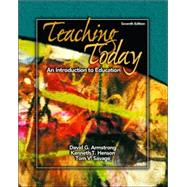
| The Profession | |
| Education in a Age of Change | |
| Becoming a Professional Educator | |
| Challenges of School Reform | |
| Learners and Their Needs | |
| Profiles of Today's Learners | |
| Responding to Diversity | |
| Meeting the Needs of Exceptional Learners | |
| Teaching and Assessing | |
| The Curriculum | |
| Effective Instruction | |
| Classroom Management and Discipline | |
| Assessing Learning | |
| Shapers of Today's Educational World | |
| Social and Philosophical Perspectives | |
| Historical Influences | |
| Influences of Technology | |
| Legal Issues Affecting Learners and Teachers | |
| Glossary | |
| Name Index | |
| Subject Index | |
| Table of Contents provided by Publisher. All Rights Reserved. |
The New copy of this book will include any supplemental materials advertised. Please check the title of the book to determine if it should include any access cards, study guides, lab manuals, CDs, etc.
The Used, Rental and eBook copies of this book are not guaranteed to include any supplemental materials. Typically, only the book itself is included. This is true even if the title states it includes any access cards, study guides, lab manuals, CDs, etc.